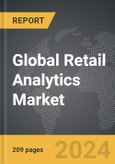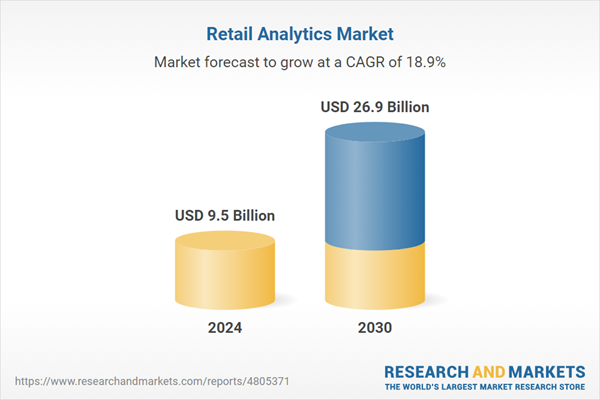The global market for Retail Analytics was valued at US$9.5 Billion in 2024 and is projected to reach US$26.9 Billion by 2030, growing at a CAGR of 18.9% from 2024 to 2030. This comprehensive report provides an in-depth analysis of market trends, drivers, and forecasts, helping you make informed business decisions. The report includes the most recent global tariff developments and how they impact the Retail Analytics market.
Segments: Component (Solutions, Services); Business Function (Finance, Marketing & Sales, Human Resources, Operations); Application (Merchandising Analysis, Customer Analytics, Pricing Analysis, Promotional Analysis & Planning, Yield Analysis, Inventory Analysis, Other Applications).
Geographic Regions/Countries: World; United States; Canada; Japan; China; Europe (France; Germany; Italy; United Kingdom; and Rest of Europe); Asia-Pacific; Rest of World.
The analysts continuously track trade developments worldwide, drawing insights from leading global economists and over 200 industry and policy institutions, including think tanks, trade organizations, and national economic advisory bodies. This intelligence is integrated into forecasting models to provide timely, data-driven analysis of emerging risks and opportunities.
Global Retail Analytics Market - Key Trends and Drivers Summarized
How Is Retail Analytics Revolutionizing the Retail Industry?
Retail analytics is fundamentally transforming the retail industry by providing deep insights into consumer behavior, inventory management, and sales trends. By leveraging data analytics tools, retailers can make informed decisions that enhance customer experiences, optimize inventory levels, and improve overall business performance. Retail analytics involves the collection and analysis of vast amounts of data from various sources, including point-of-sale systems, customer loyalty programs, and online transactions. This data-driven approach allows retailers to identify patterns and trends that can lead to more targeted marketing efforts, personalized shopping experiences, and efficient supply chain management. As competition intensifies in the retail sector, the adoption of analytics is becoming crucial for gaining a competitive edge and meeting the ever-evolving demands of consumers.What Technological Advancements Are Driving Retail Analytics?
Technological advancements are playing a critical role in the evolution of retail analytics, making it more powerful and accessible for businesses of all sizes. The advent of big data technologies, such as Hadoop and Spark, has enabled retailers to process and analyze large volumes of data in real-time, providing timely insights that can drive strategic decisions. Artificial intelligence (AI) and machine learning (ML) algorithms are also being integrated into retail analytics platforms, allowing for predictive analytics that can forecast customer behavior, optimize pricing strategies, and prevent stockouts. Additionally, the rise of cloud computing has made advanced analytics tools more accessible to small and medium-sized retailers, reducing the need for significant upfront investments in infrastructure. These technological advancements are making retail analytics an indispensable tool for retailers looking to enhance their operations and customer engagement strategies.What Are the Key Applications and Benefits of Retail Analytics?
Retail analytics is applied across various aspects of retail operations, offering significant benefits that enhance business performance and customer satisfaction. One of the key applications is in customer segmentation, where analytics helps retailers identify different customer groups based on purchasing behavior, demographics, and preferences. This enables more targeted marketing campaigns and personalized shopping experiences. Another critical application is in inventory management, where analytics helps optimize stock levels, reduce excess inventory, and prevent stockouts, leading to improved operational efficiency and cost savings. Retail analytics also plays a crucial role in sales forecasting, allowing retailers to anticipate demand and adjust their strategies accordingly. The primary benefits of retail analytics include enhanced decision-making, improved customer experiences, and increased profitability, making it a vital tool for modern retailers.What Factors Are Driving the Growth in the Retail Analytics Market?
The growth in the Retail Analytics market is driven by several factors. The increasing emphasis on customer-centric strategies is a significant driver, as retailers seek to personalize the shopping experience and build stronger customer relationships. Technological advancements, particularly in AI, ML, and big data processing, are also propelling market growth by enhancing the capabilities and accessibility of retail analytics tools. The growing adoption of e-commerce and omnichannel retail strategies is further boosting demand for retail analytics, as retailers need to integrate and analyze data from multiple channels to gain a holistic view of their operations. Additionally, the rising competition in the retail sector is contributing to market growth, as businesses invest in analytics to gain a competitive edge and improve their decision-making processes. These factors, combined with the continuous innovation in analytics technology, are driving the sustained growth of the Retail Analytics market.Report Scope
The report analyzes the Retail Analytics market, presented in terms of units. The analysis covers the key segments and geographic regions outlined below.Segments: Component (Solutions, Services); Business Function (Finance, Marketing & Sales, Human Resources, Operations); Application (Merchandising Analysis, Customer Analytics, Pricing Analysis, Promotional Analysis & Planning, Yield Analysis, Inventory Analysis, Other Applications).
Geographic Regions/Countries: World; United States; Canada; Japan; China; Europe (France; Germany; Italy; United Kingdom; and Rest of Europe); Asia-Pacific; Rest of World.
Key Insights:
- Market Growth: Understand the significant growth trajectory of the Solutions segment, which is expected to reach US$17.4 Billion by 2030 with a CAGR of a 18.6%. The Services segment is also set to grow at 19.6% CAGR over the analysis period.
- Regional Analysis: Gain insights into the U.S. market, valued at $2.7 Billion in 2024, and China, forecasted to grow at an impressive 17.9% CAGR to reach $4.1 Billion by 2030. Discover growth trends in other key regions, including Japan, Canada, Germany, and the Asia-Pacific.
Why You Should Buy This Report:
- Detailed Market Analysis: Access a thorough analysis of the Global Retail Analytics Market, covering all major geographic regions and market segments.
- Competitive Insights: Get an overview of the competitive landscape, including the market presence of major players across different geographies.
- Future Trends and Drivers: Understand the key trends and drivers shaping the future of the Global Retail Analytics Market.
- Actionable Insights: Benefit from actionable insights that can help you identify new revenue opportunities and make strategic business decisions.
Key Questions Answered:
- How is the Global Retail Analytics Market expected to evolve by 2030?
- What are the main drivers and restraints affecting the market?
- Which market segments will grow the most over the forecast period?
- How will market shares for different regions and segments change by 2030?
- Who are the leading players in the market, and what are their prospects?
Report Features:
- Comprehensive Market Data: Independent analysis of annual sales and market forecasts in US$ Million from 2024 to 2030.
- In-Depth Regional Analysis: Detailed insights into key markets, including the U.S., China, Japan, Canada, Europe, Asia-Pacific, Latin America, Middle East, and Africa.
- Company Profiles: Coverage of players such as 1010data, Inc., BRIDGEi2i Analytics Solutions Pvt. Ltd., Datawatch Corporation, Fujitsu Ltd., IBM Corporation and more.
- Complimentary Updates: Receive free report updates for one year to keep you informed of the latest market developments.
Some of the 71 companies featured in this Retail Analytics market report include:
- 1010data, Inc.
- BRIDGEi2i Analytics Solutions Pvt. Ltd.
- Datawatch Corporation
- Fujitsu Ltd.
- IBM Corporation
- Information Builders, Inc.
- Manthan Systems, Inc.
- Microsoft Corporation
- MicroStrategy, Inc.
- Oracle Corporation
- Qlik Tech International AB
- SAP SE
- SAS Institute, Inc.
Tariff Impact Analysis: Key Insights for 2025
Global tariff negotiations across 180+ countries are reshaping supply chains, costs, and competitiveness. This report reflects the latest developments as of April 2025 and incorporates forward-looking insights into the market outlook.The analysts continuously track trade developments worldwide, drawing insights from leading global economists and over 200 industry and policy institutions, including think tanks, trade organizations, and national economic advisory bodies. This intelligence is integrated into forecasting models to provide timely, data-driven analysis of emerging risks and opportunities.
What’s Included in This Edition:
- Tariff-adjusted market forecasts by region and segment
- Analysis of cost and supply chain implications by sourcing and trade exposure
- Strategic insights into geographic shifts
Buyers receive a free July 2025 update with:
- Finalized tariff impacts and new trade agreement effects
- Updated projections reflecting global sourcing and cost shifts
- Expanded country-specific coverage across the industry
Table of Contents
I. METHODOLOGYII. EXECUTIVE SUMMARY2. FOCUS ON SELECT PLAYERSIII. MARKET ANALYSISIV. COMPETITION
1. MARKET OVERVIEW
3. MARKET TRENDS & DRIVERS
4. GLOBAL MARKET PERSPECTIVE
UNITED STATES
CANADA
JAPAN
CHINA
EUROPE
FRANCE
GERMANY
ITALY
UNITED KINGDOM
REST OF EUROPE
ASIA-PACIFIC
REST OF WORLD
Companies Mentioned (Partial List)
A selection of companies mentioned in this report includes, but is not limited to:
- 1010data, Inc.
- BRIDGEi2i Analytics Solutions Pvt. Ltd.
- Datawatch Corporation
- Fujitsu Ltd.
- IBM Corporation
- Information Builders, Inc.
- Manthan Systems, Inc.
- Microsoft Corporation
- MicroStrategy, Inc.
- Oracle Corporation
- Qlik Tech International AB
- SAP SE
- SAS Institute, Inc.
Table Information
| Report Attribute | Details |
|---|---|
| No. of Pages | 209 |
| Published | April 2025 |
| Forecast Period | 2024 - 2030 |
| Estimated Market Value ( USD | $ 9.5 Billion |
| Forecasted Market Value ( USD | $ 26.9 Billion |
| Compound Annual Growth Rate | 18.9% |
| Regions Covered | Global |









